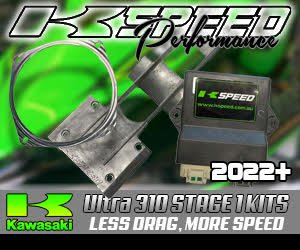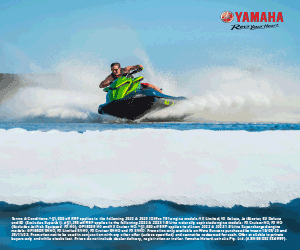
It makes sense for manufacturers to design and build a powerplant that can (and often will) surpass the expectations of the general riding public. In doing so, the OE can detune or otherwise restrict to the engine from performing at its peak limit, and rather, offer the customer a portion of its full potential. This saves the engine from operating within the narrow boundaries wherein a minor error could spell disaster.
All three manufacturers do this – Kawasaki, Yamaha and Sea-Doo – and for good reason. Equally, the aftermarket seeks to “unlock” this otherwise buried potential often through expensive and invasive means. Yet, what if you could unleash the latent power within say, Sea-Doo’s 300 ACE 1630 3-cylinder four-stroke within a matter of seconds. (Yes, seconds not minutes or hours.)
And what if guaranteeing engine longevity and improving straightline stability at speed and high speed cornering could be done nearly as quickly? Below we’ll list three “must have” performance upgrades from RIVA Racing that will unlock the hidden potential within your 300-horsepower supercharged Sea-Doo all without any permanent modifications, drilling or cutting. Yup, everything here is 100% reversible and can be done in less than an hour.
In the case of all supercharged 300-horsepower Sea-Doos, BRP intentionally caps the 300 ACE engine at just above 8,000rpm. For units sold in the United States, that means an RXT-X 300 or GTX Limited 300 might blip the speedometer at 70 (or even 71) miles per hour before the dashboard communicates to the ECU, which then dictates to the throttle body to ease back to 68 or so. All of this is done within fractions of a second, of course, but that’s how it works.

For international units (an “RS” unit), the RPM cap remains the same, but the speedometer is allowed to climb a little deeper into the 70s. To interrupt this signal, RIVA Racing engineered its Speed Control Override Module (or SCOM). The Speed Control Override Module does not connect to your Sea-Doo’s ECU whatsoever. It merely interrupts the signal between the GPS speedometer and the ECU, keeping the computer from backing off of the throttle once it hits its preset max speed.
Again, the ECU’s cap on RPM remains in place meaning you will not see excessive RPM that would void the OE warranty, but the SCOM will allow the Sea-Doo to proceed to speeds within the mid-to-high 70’s when ideal conditions. RIVA Racing includes a pair of brackets (one for the RXP-X and the other for the RXT-X/GTX). Rather than use the bracket, we opted to secure the SCOM with a couple of heavy duty zip ties. It won’t bounce or jostle much more than it would on the bracket, and it can be quickly removed whenever we want.
Prior to installation, always disconnect the battery. We had attempted to install a SCOM on a RXT-X 300 without doing so, and the effects of the override module weren’t visible at first. Once installed, our 2021 Sea-Doo RXP-X 300 (as will as SCOM-installed machines) began in “Sport Mode” – the prompt crossing the bottom of our dashboard. All other dashboard features remain in full function of course, as the SCOM does not reprogram the ECU.
Next on our list is RIVA Racing’s Oil Catch/Separator. As many are prone to say, all engines are effectively air pumps with negative atmosphere (vacuum) pulling air in, and positive atmosphere (pressure) pushing air out. The intake charge is hyper-pressurized by the supercharger, and “blows by” the sides of the pistons, pressurizing inside of your Sea-Doo’s crankcase while under throttle.
This pressurized air mixes with oily vapor that’s roiling inside of your crankcase and needs to be extracted. Normally, this oily vapor would be siphoned out and sucked in past the throttle body, through your intercooler and past your supercharger; coating everything in an oily film.
In small doses, this won’t hurt your engine – and in some instances when riding in salty air, the oily coating can sometimes help protect these sensitive parts. But if left unchecked, the film that can collect over time may heavily hinder your intercooler’s ability to chill an intake charge, and worse yet, cause carbon build up in your cylinders, clogging combustion.
The catch can retrieves and separates the oil from the air, evacuating it through a screened filter. In doing this, the catch can is definitely a “must have” for those looking to rack up some serious hours on their supercharged Sea-Doo; and like the SCOM installs in minutes without any permanent cutting or drilling. The bottle mounts to the provided CNC-cut aluminum bracket, which for our 2021 RXP-X, mounted up using the existing outermost bolts of the exhaust manifold.
RIVA includes several feet of PCV hose to connect the catch can to the factory PCV valve; simply reuse the factory hose clamps and re-ziptie the wire loom to the new hose. Although not part of RIVA’s kit, we addressed the hole in the intake tube by snipping a short length of the provided PCV hose and capping it with a black rubber boot we had in the garage. This cap slipped over the plastic factory nipple, sealing off the vacuum leak the hole would leave.
Finally, we can reattach our battery’s terminals, reinstall the engine inspection cover and seats, and begin our sponson upgrade. But why? The factory sponsons on the current RXP-X 300 (which are also identical to the sponsons found on the 2018-and-newer RXT-X 300) are a single piece of molded plastic; gone are the adjustable X-sponsons from previous years. The blades are somewhat deeper than the standard sponsons, but are rather blunt, kicking up a wide roost and offering only the slightest bit of improved traction due to their increased drag.
The best way to demonstrate the night-and-day difference between the RIVA Pro Series Sponsons and the factory sponsons is in a side-by-side comparison. Notice that the depth and angle (what you might call “negative camber”) of the blade is considerable, allowing the sponson to cut far deeper and at a vertical angle when the RXP-X rolls into a tight corner. The deepest portion of the blade is at the foremost, pushing the hull’s “pivot point” forward.
Effectively, the RIVA Pro Series Sponsons permits the RXP-X’s T3R hull to perform far more aggressively than the factory blades would allow. The molded plastic OE sponsons failed to give sufficient “bite” in full-throttle, leaned-over turns; the Pro Series do. Equally, the Pro Series Sponsons do not rely on generating drag alone (as indicated by the stepped edge of the blade) but rather, favoring forward and tapering at the tail, placing all of the traction around the intake grate.
We discovered how aggressive these new sponsons could be during our first “test run” of our trio of upgrades. Even with the engine cold, we quickly sped up to 71mph with a half-full tank of fuel. With the blades set to #4, the RXP-X bit sharply, snapping the ski hard inward, and high-siding us nearly off of the unit. In full speed runs, the deep-set blades could easily be felt “guiding” our tail, which was more engagement than we wanted.

Returning a couple of days later with less fuel in the tank and the sponsons moved up one spot to the #3 position, we could snap a hairpin with ease and confidence without much effort. Equally, we clicked off a consecutive series of 75 and 76mph top speed runs on the dashboard’s speedometer. Our iPhone’s GPS app read a more conservative 74.9mph, so we averaged the two for a safe 75.5mph, which we felt was impressive given our 240-pound rider and 445-foot elevation.
In all, an hour’s worth of work and three extraordinarily easy-to-install parts from RIVA Racing are all it takes to unlock a large portion of any 300-horsepower Sea-Doo. Best of all, each of these are 100-percent reversible and transferable to another 300 ACE-powered machine (yes, from a RXT-X to a RXP-X to a GTX 300). Go to the links provided above or visit www.rivaracing.com and check ’em all out there.
































Very cool video. Going to see more of your video and like the idea of adding the blades what protects the engine and your machine from salt build up.